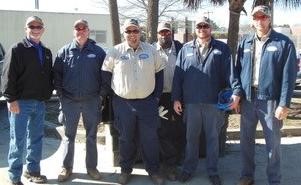
Center Street WPCF in Mt. Pleasant, SC.
The Lowcountry is often used to describe a large region incorporating a number of counties in South Carolina. The moniker is apt, because this region is flatter than flat. This topography creates a unique challenge for wastewater treatment operations in the coastal communities situated along the South Carolina shoreline, as Greg Hill, Wastewater Operations Supervisor at Mount Pleasant Waterworks in South Carolina explains.
“In 2012 we did an assessment of the infrastructure at our Center Street Wastewater Treatment Facility. As part of a capital investment program we resolved to upgrade the mixing technology at this facility. There were a number of concerns with the legacy diffused air mixing system we had in place at the time as it was energy intensive and unable to mix effectively at low water levels in our equalization basin. Moreover, we wanted an equally low maintenance alternative to mechanical mixing in the planned ASB basins.
“We still wanted to reuse our existing infrastructure, but we had to factor in some unique features: we have a small footprint, are located almost on the beach and have to cope with extremely low water levels in the influent equalization tank.” The municipality, however, still wanted to reuse its existing concrete treatment structures. The upgrade took about two years to complete. “We were one of the first municipal facilities to use BioMix compressed gas mixing technology in flow equalization and anoxic selectors in our secondary biological treatment process. As a wastewater plant operator, Mt. Pleasant Waterworks likes to set the standard. We like leading the way.”

Greg Hill (left) alongside MPWW Operations Team
“Like most systems with occasional high volumes of inflow due to events such as hurricanes, at Mt. Pleasant Waterworks we prepare for those events by strategic influent equalization planning. However, we can’t empty the tanks – we have to keep at least a 2-ft. level of water mixing in the tank and have to minimize odors as we are surrounded by homes and a school. As a beach community, high tides can be problematic during these high flow events because we may receive a lot of inflow and infiltration. BioMix allows us to operate the EQ at varying levels, which minimizes any negative impacts with the biological process. Using BioMix, we can uniformly mix the equalization tank at all levels. Also, by opting for anoxic selectors in our biological treatment process, we can mix the selectors with BioMix without creating dissolved oxygen, which allows the anoxic zone to operate properly and produce high quality effluent.”
The EnviroMix BioMix system works well at variable water levels in the equalization tank due to the use of compressed air as opposed to the low-pressure air systems that normal aeration systems require. Some 72 nozzles are distributed across the mixing basin floor, preventing the build-up of solids even when water levels fall to very low levels. This flexibility proved to be a life-saver during Hurricane Irma, the worst storm event to batter Coastal Carolina since Hurricane Hugo. In September 2017, the Lowcountry was hit hard by Hurricane Irma; the city and many local neighborhoods experienced a 10-ft. storm surge – one of the worst tidal surges since the unforgettable Hugo. Yet, according to Mr. Hill, the Mt. Pleasant treatment facility did its job even under the worst surge conditions: “We didn’t spill a drop when the storm surge arrived, even though it happened during high tide and tidal water flowed into manholes from the collection system and residential clean outs – we held up well to the storm.” Fortunately, when the storm passed and low tide set in, conditions improved drastically.
The EnviroMix approach to energy efficient and low maintenance mixing has shown demonstrable benefits and cost savings. Mr. Hill points to actual capital improvements. “If we’d stayed with the previously designed mechanical mixers recommendation we would have needed to build additional walkways and catwalks to our existing structures and incorporate new rigging such as cables and hoists, which is much more maintenance intensive for us from an operations perspective. We have reduced our operations and maintenance requirement significantly by going with BioMix.”
According to Mr. Hill, there are intangible benefits that also need to be considered when upgrading a mixing system: “The EnviroMix solution is super user-friendly. Most every operator can operate this system with minimum training. The operators find it easy to understand and we can get newer operators familiar with the system very quickly. When we needed to clean the previous system, I had to put a whole crew on it. Using EnviroMix, one man can clean a tank from the topside using a high-pressure hose. That’s a big advantage for us, because we have to minimize the effects of any downtime.”
Contact Dave Lauer for more information at [email protected].


